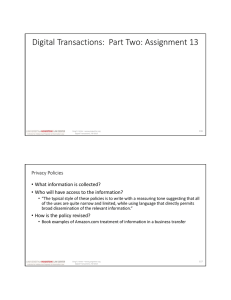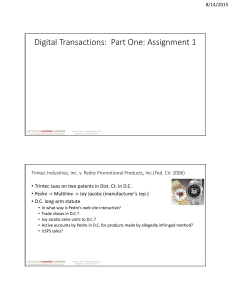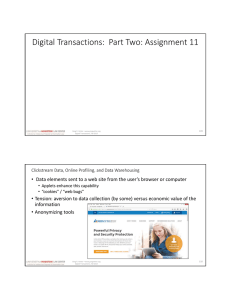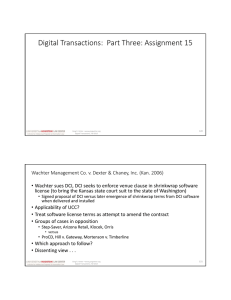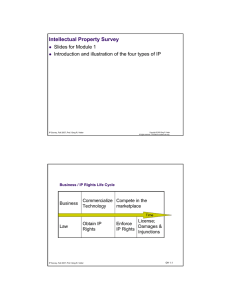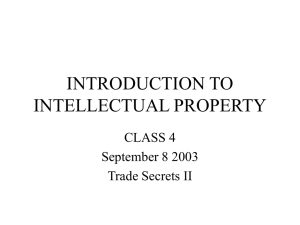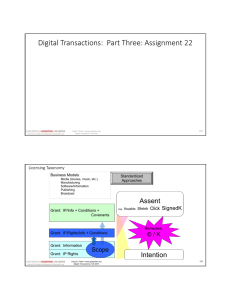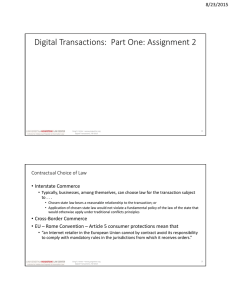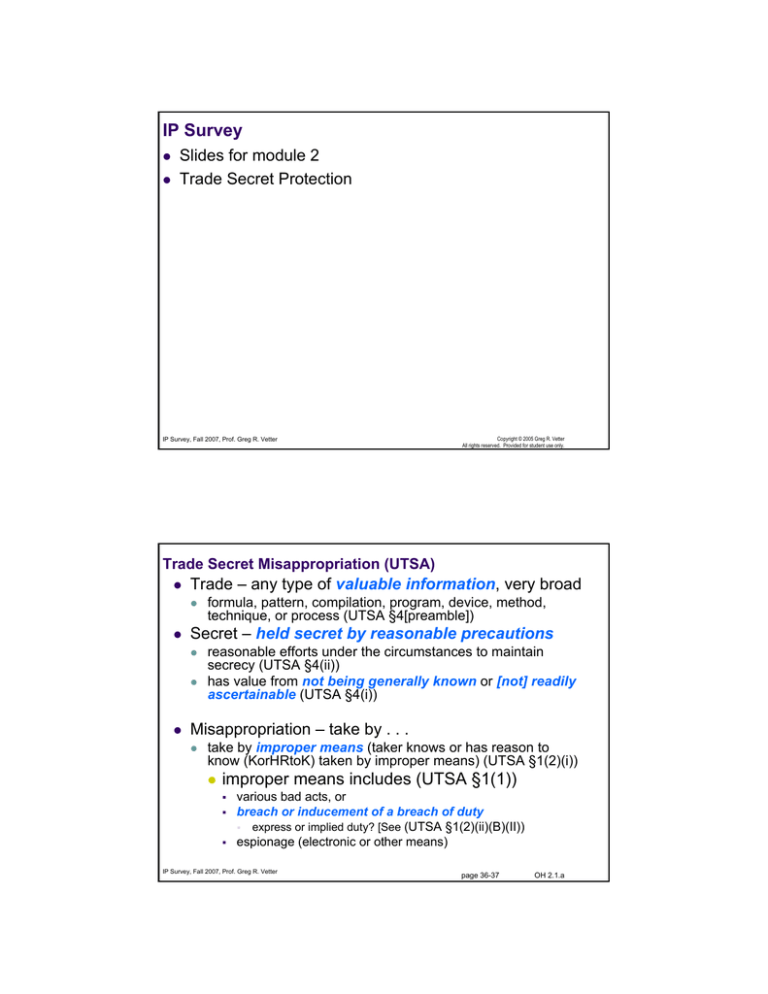
IP Survey
z
z
Slides for module 2
Trade Secret Protection
IP Survey, Fall 2007, Prof. Greg R. Vetter
Copyright © 2005 Greg R. Vetter
All rights reserved. Provided for student use only.
Trade Secret Misappropriation (UTSA)
z
Trade – any type of valuable information, very broad
z
z
Secret – held secret by reasonable precautions
z
z
z
formula, pattern, compilation, program, device, method,
technique, or process (UTSA §4[preamble])
reasonable efforts under the circumstances to maintain
secrecy (UTSA §4(ii))
has value from not being generally known or [not] readily
ascertainable (UTSA §4(i))
Misappropriation – take by . . .
z
take by improper means (taker knows or has reason to
know (KorHRtoK) taken by improper means) (UTSA §1(2)(i))
z
improper means includes (UTSA §1(1))
various bad acts, or
breach or inducement of a breach of duty
express or implied duty? [See (UTSA §1(2)(ii)(B)(II))
espionage (electronic or other means)
IP Survey, Fall 2007, Prof. Greg R. Vetter
page 36-37
OH 2.1.a
Trade Secret Misappropriation (UTSA)
z
Misappropriation z
disclosure or use w/out express or implied consent by one
who meets the following (USTA §1(2)(ii))
z acquired knowledge of the trade secret (more than “took”
it?) by improper means (USTA §1(2)(ii)(A))
z KorHRtoK that her/his knowledge of the trade secret was
at time of disclosure or use: (USTA §1(2)(ii)(B))
z
derived from one who took by improper means
acquired under circumstances giving rise to a duty to maintain its
secrecy or limit its use
derived from one under a duty to P to maintain its secrecy or limit its
use
before a material change in obtainer’s position, KorHRtK
that (i) info is a TS, and (ii) obtained by accident or
mistake. (USTA §1(2)(ii)(C))
IP Survey, Fall 2007, Prof. Greg R. Vetter
page 36-37
OH 2.1.b
Trade Secret Misappropriation (UTSA)
(1) “Improper means” includes theft, bribery, misrepresentation, breach or inducement of a breach of
a duty to maintain secrecy, or espionage through electronic or other means;
(2) “Misappropriation” means:
(i) acquisition of a trade secret of another by a person who knows or has reason to know that the
trade secret was acquired by improper means; or
(ii) disclosure or use of a trade secret of another without express or implied consent by a person
who
(A) used improper means to acquire knowledge of the trade secret;
or
(B) at the time of disclosure or use, knew or had reason to know that his knowledge of the
trade secret was
(I) derived from or through a person who had utilized improper means to acquire it;
(II) acquired under circumstances giving rise to a duty to maintain its secrecy or limit
its use; or
(III) derived from or through a person who owed a duty to the person seeking relief
to maintain its secrecy or limit its use; or
(C) before a material change of his [or her] position, knew or had reason to know that it
was a trade secret and that knowledge of it had been acquired by accident or mistake.
IP Survey, Fall 2007, Prof. Greg R. Vetter
page 36-37
OH 2.1.c
Trade Secret Definitions
Restatement
of Torts
A trade secret may consist of any formula, pattern, device or compilation
of information which is used in one's business, and which gives him an
opportunity to obtain an advantage over competitors who do not know or
use it. It may be a formula for a chemical compound, a process of
manufacturing, treating or preserving materials, a pattern for a machine
or other device, or a list of customers.
- [6 factors, pg. 45]
UTSA
(4) “Trade secret” means information, including a formula, pattern,
compilation, program, device, method, technique, or process, that:
(i) derives independent economic value, actual or potential, from not
being generally known to, and not being readily ascertainable by proper
means by, other persons who can obtain economic value from its
disclosure or use, and
(ii) is the subject of efforts that are reasonable under the circumstances
to maintain its secrecy.
Restatement
(3d) of Unfair
Competition
A trade secret is any information that can be used in the operation of a
business or other enterprise and that is sufficiently valuable and secret
to afford an actual or potential economic advantage over others.
IP Survey, Fall 2007, Prof. Greg R. Vetter
page 35-37, 42-43, 47
OH 2.2
Trade Secret Protection Justification
z
Utilitarian
z
z
z
Protection of trade secrets creates incentive to develop
technology
What, if any, disadvantages does trade secret protection
have?
Tort-based - deterrence of wrongful acts against
commercial morality and good faith dealings
z
Tort-based theory merges with common law breach of
contract when the duty underlying the trade secret claim
is a duty arising from contract
IP Survey, Fall 2007, Prof. Greg R. Vetter
page 38-39
OH 2.3
Metallurgical Indus. (MI) v. 4Tek
z
Recycling technology
IP Survey, Fall 2007, Prof. Greg R. Vetter
page 39-49
OH 2.4.a
Metallurgical Indus. (MI) v. 4Tek
z
z
“zinc recovery” is a better process than “cold
stream” to recover high-value carbide
Mr. Bielefeldt assisting to build zinc recovery
furnaces
z
z
z
MI’s contract is with Therm-O-Vac (TOV)
Bielefeldt is a representative of TOV
MI’s improvements because technology not
working
z
Notices to Bielefeldt that processes is confidential and
disclosures in confidence
IP Survey, Fall 2007, Prof. Greg R. Vetter
page 39-49
OH 2.4.b
Metallurgical Indus. v. 4Tek
z
What types of information can be protected as a
TS?
z
z
z
z
Improvements, implementations
“negative” know-how
What makes information a TS?
What degree of secrecy is required?
z
z
Evidence of a secrets existence?
Effect of disclosures?
z
When does a disclosure not defeat secrecy?
z
Sufficiently limited and in holder’s economic interest
Implications of the test for this?
IP Survey, Fall 2007, Prof. Greg R. Vetter
page 39-49
OH 2.4.c
Metallurgical Indus. v. 4Tek
z
What about the misappropriation element?
z
Hypothetical cases based on note 2, pg. 44,
assuming that the process improvements are a
valid TS
z
4Tek never was involved with MI and learns of the
process improvements from the other furnace company,
and then uses it to try to sell it to Smith
z
z
What part of the UTSA would need analysis?
What else would we need to know?
IP Survey, Fall 2007, Prof. Greg R. Vetter
page 39-49
OH 2.4.d
Metallurgical Indus. v. 4Tek – select notes
z
Six factors, note 5
z
z
z
z
z
z
z
extent known outside claimant’s business
extent known by employees and others involved in the
business
measures taken to guard secrecy
value of the information for claimant / competitors
cost / effort to develop
ease of difficulty of independent acquisition or
duplication
Known or knowable debate, notes 7 & 8
IP Survey, Fall 2007, Prof. Greg R. Vetter
page 45-47
OH 2.5
Rockwell v. DEV
z
z
z
z
IP Survey, Fall 2007, Prof. Greg R. Vetter
Mr. Fleck & Peloso
Piece Part Drawings
(PPD)
Rockwell’s
engineers and
vendors
PPDs versus
assembly drawings
page 49-58
OH 2.10.a
Rockwell v. DEV
z
What were Rockwell’s efforts to
keep drawings secure?
z
z
z
z
z
Under what conditions will
disclosure impose a duty on the recipient?
z
z
Drawing legends?
Use of NDAs? Enforcement?
Copies of drawings?
What else could it have done?
Disclosure necessary to the exploitation of a TS
Two roles of “reasonable efforts”
z
z
Remedial
Evidentiary
IP Survey, Fall 2007, Prof. Greg R. Vetter
page 49-58
OH 2.10.b
Rockwell v. DEV
z
Precautions:
z
z
Effect of greater precautions?
Are these evidence of the value prong of a TS?
z
“Perfect security is not optimum security”
z
Map this case to the UTSA
z
z
z
“not generally known” AND
“subject to reasonable efforts”
Information can’t be turned into a TS simply by treating it as a TS
IP Survey, Fall 2007, Prof. Greg R. Vetter
page 49-58
OH 2.10.c
Trade Secret – notes from Rockwell v. Dev
z
Problem 2-5
z
Smith accidentally develops drink formula
z
z
z
Trying to keep it secret
z
z
z
Mixture of three common ingredients
Called “Mobile Mud”
Premix it in back
Tell bartenders not to disclose
Jimmy Dean copies it
z
An expert can determine formula by looking, smelling and
tasting
IP Survey, Fall 2007, Prof. Greg R. Vetter
page 57-58
OH 2.11
Disclosure of a TS
z Publish
z Yet, publishing occurs a lot. Inventors don’t think about protection or
want the prestige. Example: an issued patent.
z Selling commercial product that embodies the secret
z If fully disclosed by the products produced from its use, protection may be
fully lost.
z Recall Metallurgical Industries – court found that disclosure only for profit
would weigh in favor of being a TS. Why should that be the case?
Licensing is evidence of value, but selling information is evidence of
attempts to profit from its disclosure.
z TS may be publicly disclosed by someone other than TS owner
z Independent discoverer.
z If taken from owner A, and published by B, can A still protect it as TS?
What about C, who learns of it from publication and uses it?
z Inadvertent disclosure
z Minimal caselaw, if accidental and not widespread, perhaps still a TS.
z If widespread, unfair to hold third parties liable?
z But, UTSA §1(2)(ii)(C), it is misappropriation to disclose TS if one knows
or has reason to know TS acquired “by accident or mistake.”
z Government required disclosure
z Labeling of foods, drugs. Hazardous materials labeling and disclosure.
IP Survey, Fall 2007, Prof. Greg R. Vetter
page 58-62
OH 2.12
Dupont v. Christopher
z
Procedural posture?
z
z
z
z
Does Dupont state a claim?
TS is a method for producing
methanol
Method is potentially
discoverable during plant
construction
Anything illegal about the
flight?
z
z
Trespass?
FAA?
IP Survey, Fall 2007, Prof. Greg R. Vetter
page 62-67
OH 2.13.a
Dupont v. Christopher
z
Outcome as analyzed by the court?
z
z
z
Outcome under UTSA?
z
z
Is aerial photography an improper means?
How does this compare to inspecting and analyzing an
openly sold product?
“Improper means” includes theft, bribery,
misrepresentation, breach or inducement of a breach of
a duty to maintain secrecy, or espionage through
electronic or other means
Commercial privacy must be protected from
espionage which could not have been reasonably
anticipated or prevented
z
Cost to prevent another’s spying dampens the spirit of
inventiveness
IP Survey, Fall 2007, Prof. Greg R. Vetter
page 62-67
OH 2.13.b
Dupont v. Christopher
z
HYPO – purchasing a satellite image from an
internet web site?
IP Survey, Fall 2007, Prof. Greg R. Vetter
OH 2.13.c
Smith v. Dravo
z
z
z
z
IP Survey, Fall 2007, Prof. Greg R. Vetter
What did Dravo want to buy
from Smith’s company,
Safeway containers?
What disclosures occurred from
Dravo and Smith’s discussions?
When purchase negotiations
broke down, what did Dravo
do?
What resulted for Smith’s
business from Dravo’s actions?
page 67-72
OH 2.20.a
Smith v. Dravo
z
z
Importance of interchangeability between plaintiff
and defendant’s containers?
Was Dravo in a position of trust or confidence?
z
z
z
z
How did this arise?
Taking the “burden with the good”
Role of access in misappropriation determination?
Other arguments on Dravo’s behalf?
z
Problems with implied confidential relationships?
IP Survey, Fall 2007, Prof. Greg R. Vetter
page 67-72
OH 2.20.b
Smith v. Dravo
RS 3d of Unfair Competition – confidential
relationship is established when:
z
express promise of confidentiality prior to disclosure of
TS
TS disclosed under circumstances where relationship
or other facts justify the conclusion that, at the time of
disclosure:
z
z
z
z
person KorHRtoK that disclosure intended in confidence;
AND
other party to disclosure (discloser) was reasonable in
inferring that the receiver consented to confidentiality.
IP Survey, Fall 2007, Prof. Greg R. Vetter
page 67-72
OH 2.20.c
Problem 2-8
z
z
z
Customer sends idea to ToolCo
ToolCo manufactures tool
Is Customer entitled to compensation? How might
the following facts change the analysis?
z
z
z
ToolCo actively solicited?
Customer sent idea with letter saying he wanted to
negotiate a licensing agreement?
ToolCo has an informal policy of compensating idea
submitters?
IP Survey, Fall 2007, Prof. Greg R. Vetter
page 72
OH 2.21
page 75-80
OH 2.23
Kadant v. Seely Machine
z
Kadant’s product lines
z
Corlew’s role at Kadant
z
z
Transition to Seely
Activity at Seely
IP Survey, Fall 2007, Prof. Greg R. Vetter
Warner-Lambert v. Reynolds
z
z
What is basis for Warner-Lambert’s argument to
limit payments?
Problems with these arguments?
z
z
z
z
Source of law and policy differences among different
types of IP?
Risk allocation via contract?
Any issues with the original contract including a
clause that payments stop if the formula loses
trade secret status?
Implications for licensing technology?
IP Survey, Fall 2007, Prof. Greg R. Vetter
page 101-104
OH 2.24

